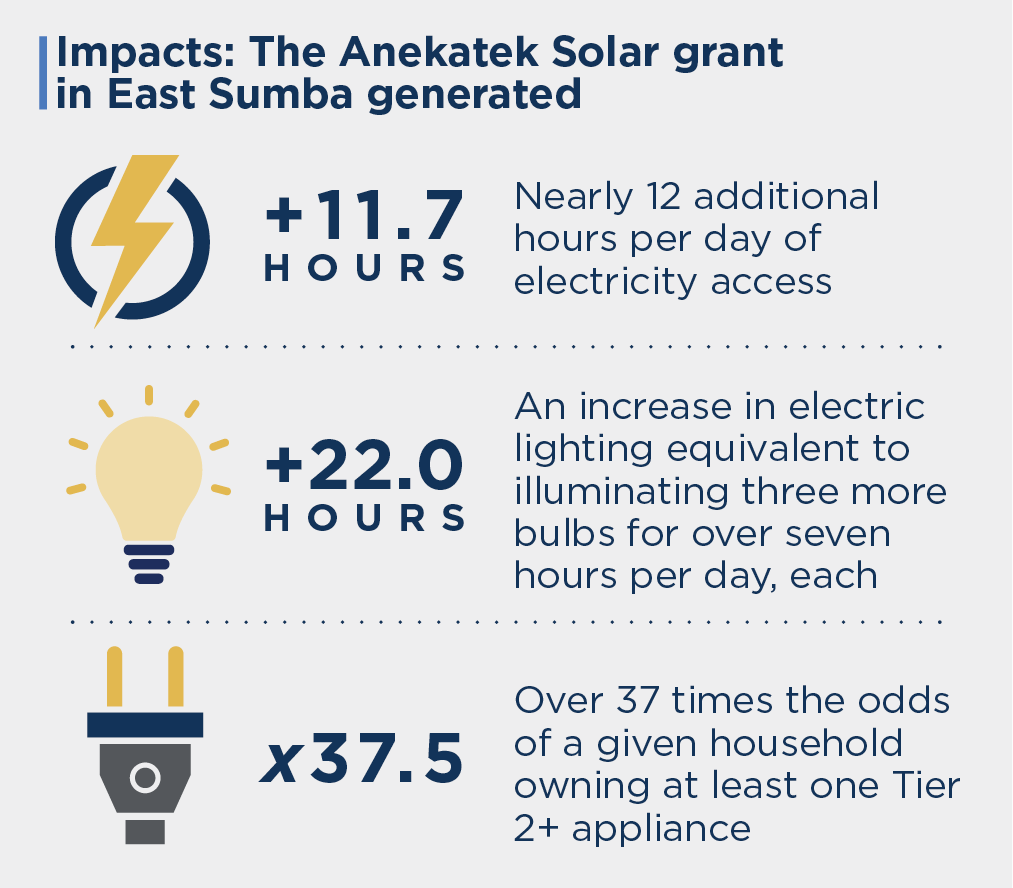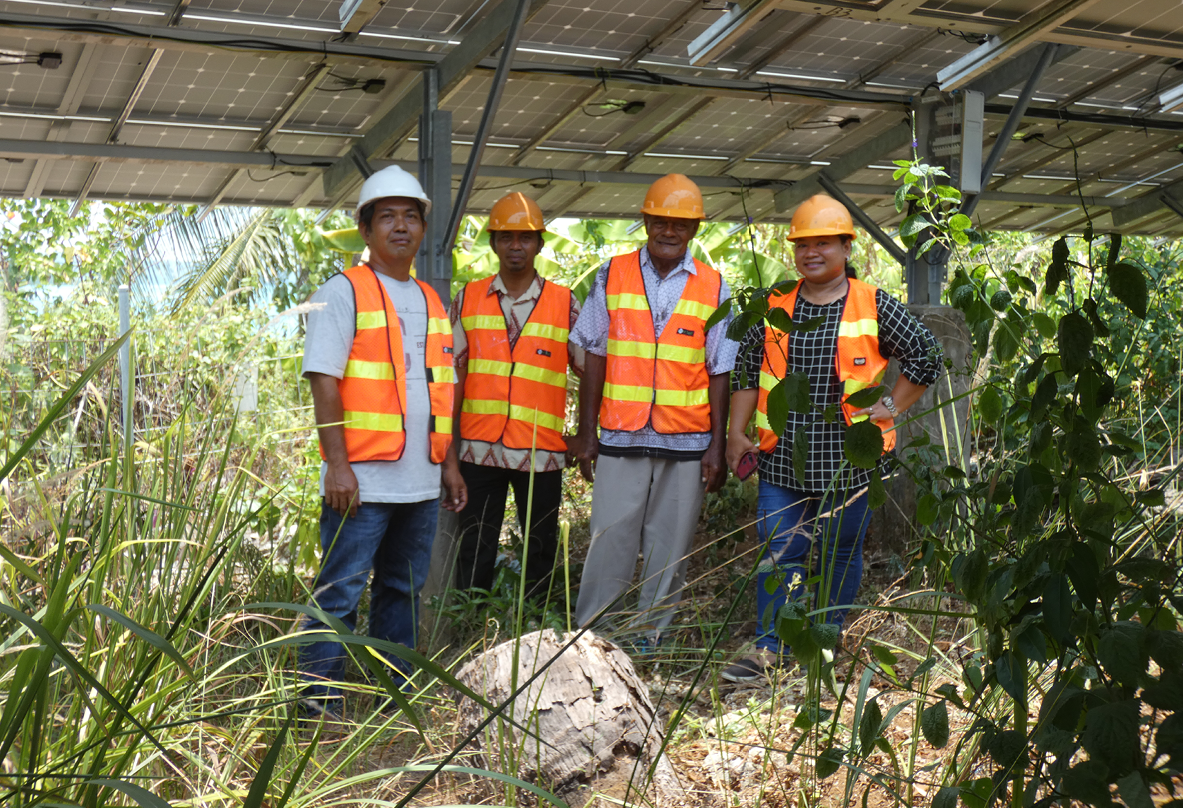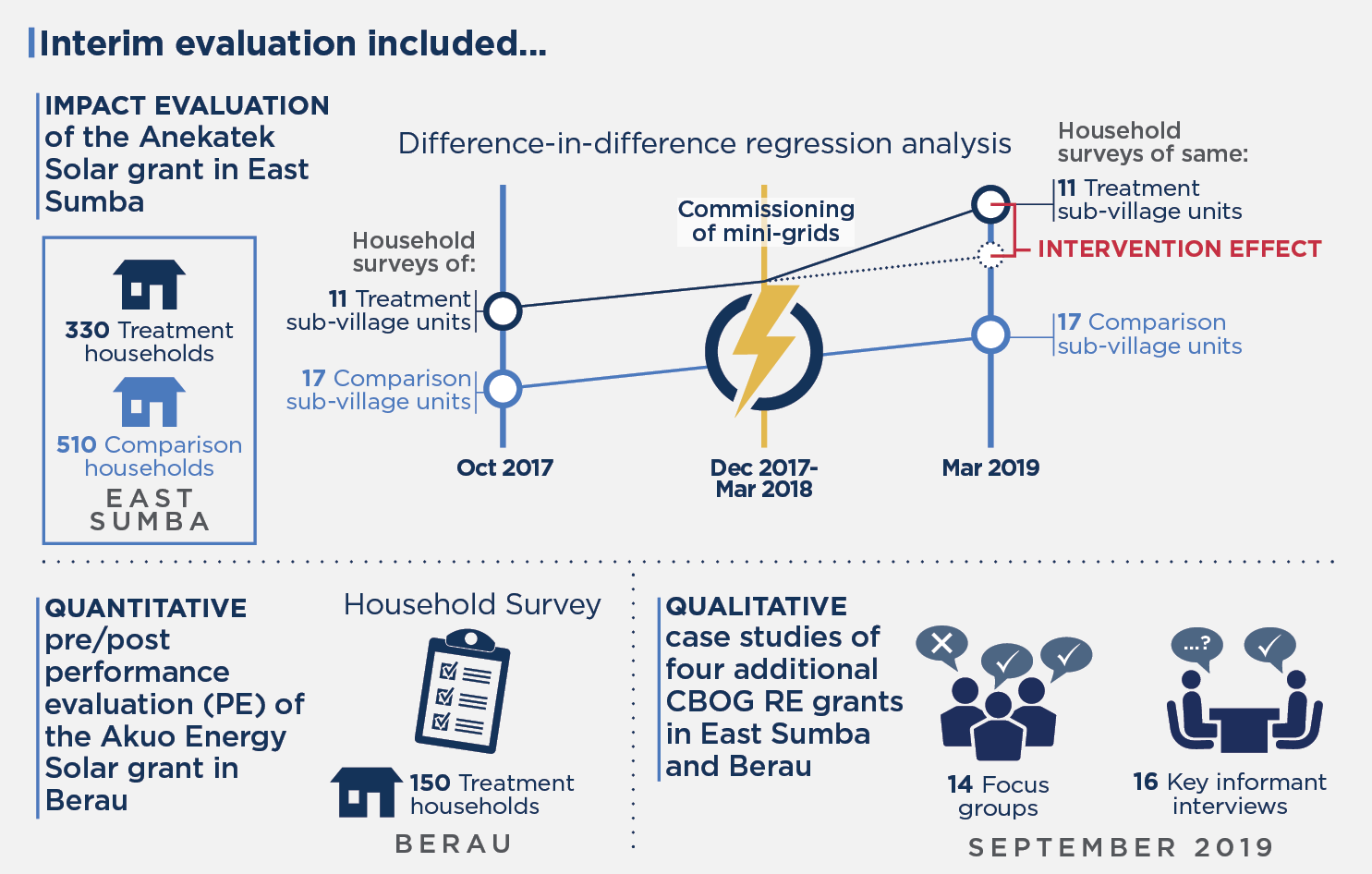Program Overview
MCC’s $474 million Indonesia Compact (2013-2018) included the $288 million Green Prosperity (GP) Project that aimed to increase economic productivity and reduce land-based greenhouse gas emissions. The project funded 26 community-based off-grid (CBOG) renewable energy (RE) grants totaling $85.3 million. Some were designed as community-owned RE projects, while others were RE components of natural resource management projects. These grants sought to substitute renewable energy for fossil fuels in remote and rural communities, opening opportunities for social and economic improvements through access to electricity.
Key Findings
Domestic Use of Electricity
- Access to the Anekatek and Akuo Energy mini-grids in East Sumba and Berau increased lighting and use of domestic appliances.
- Other off-grid renewable energy sources in East Sumba were used mostly for lighting.
Fuel Substitution and Greenhouse Gas Emissions
- Where off-grid renewable energy assets were used for domestic purposes, they caused reductions in diesel and kerosene use, making reduced greenhouse gas emissions highly likely.
Economic Use of Electricity
- Access to compact-funded mini-grids did not increase income or economic use of electric appliances, except for the occasional refrigerator used to sell chilled goods.
- Access to compact-funded non-mini grid technology showed mixed results for use in economically productive activities.
Barriers to Financial and Operational Sustainability
- Barriers include lower-than anticipated demand for electricity, regulatory pressures, high operations costs, and lack of external subsidies.
- The only grants with sustainable models were Hivos, which established RE infrastructure servicing companies, and the Anekatek solar mini-grid scheme.
Evaluation Questions
The interim impact and performance evaluation of the off-grid renewable energy grant portfolio focuses on six grants. A quantitative analysis of two grants answers Questions 1-4 that will be revisited during the final evaluation. Case studies of four grants answer Questions 5-7.
- 1
How have energy consumption patterns changed among beneficiary households and businesses in response to the provision of a renewable source of electricity? - 2
Has the electricity provided through the RE infrastructure been used for economic purposes at the community or household level? - 3
To what extent do any changes in energy consumption patterns favor reduced greenhouse gas emissions? - 4
Has the special purpose vehicle (SPV) been an effective intervention to improve community buy-in and sustainability of the infrastructure? - 5
What were the grant theories of change regarding deployment and use of RE infrastructure? - 6
How did the grants approach ensuring the sustainability of RE infrastructure, and to what extent were they successful? - 7
What outcomes do targeted communities perceive to have resulted from the RE infrastructure, and how do these compare with the outcomes envisioned in the theory of change?
Detailed Findings
Domestic Use of Electricity

Most of the grants targeted domestic uses of electricity in the short term, with economic uses expected in the long-term, if at all. Such domestic uses included lighting, studying, and powering of appliances and public facilities. These uses were prominent for the Akuo Energy, Anekatek, and Hivos grants. For Anekatek, the mini-grids provided nearly 12 hours per day of additional electricity access and increased the likelihood that domestic appliances would be used. Domestic appliance use was reported to alleviate the burden of domestic tasks typically assigned to women, such as cooking and retrieving water.
Fuel Substitution and GHG Emissions
In 2017, 89% of Akuo Energy treatment households in Berau and 21% of Anekatek treatment households in Sumba used at least one non-renewable source of energy, while in 2019, only 1% and 3% did so. Reduction in diesel consumption is especially notable—by 1.6 liters per household per month due to the Anekatek grant, and by as much as 7.0 liters per household per month due to Akuo Energy grants. Households that used kerosene for night-time lighting can now use the light provided by mini-grid electricity or Hivos solar lamps. Village-level diesel generators used before the commissioning of Akuo Energy mini-grids are no longer used. Even in Sumber Agung, where the intended economic uses of solar energy have not materialized, the solar power plant is used in place of diesel generators to power village public facilities.
Economic Use of Electricity

Teluk Alulu operators and evaluator
Significant economic benefits pursued by the Anekatek, Akuo Energy, and IBEKA grants were not expected to have materialized at the time of the evaluation (1.5 years after introduction of the mini-grids), and indeed economic benefits appear minimal. There was some evidence of increased time spent on productive activity and of the sale of refrigerated goods, but little evidence of increased income or of new businesses using the source of electricity to power value-adding appliances.
Barriers to Financial and Operational Sustainability
For most of the grants, arrangements to fund operations and maintenance may not be enough to cover a large expense, because electricity tariffs are set below the cost of production and demand is low. The PEKA grant in Berau saw most of its assets fail in 2018 for lack of maintenance. The IBEKA and Javlec grants contend with unclear legal ownership and insufficient revenue. After the grantee subsidy expires in March 2020, operations and maintenance funding for the Akuo Energy mini-grids will be insufficient, and continued sustaining the Anekatek mini-grids will require external subsidy, barring increased demand. The Hivos grant, however, created a renewable energy service company, perhaps ensuring the assets’ longevity.
Economic Rate of Return
MCC considers a 10% economic rate of return (ERR) as the threshold to proceed with investment. While the evaluator did not recalculate the ERRs, they provided feedback on the validity of the ERRs produced by MCA (19.45% to 26.45%) in light of the evaluation findings. Four of the six grants had known ERRs: Akuo Energy, Anekatek, W2 PEKA, and W2 Javlic grants. Although the evaluation did not recalculate the ERRs, it did assess the plausibility of the underlying assumptions. The evaluation found that benefits will probably be lower than hypothesized for all four grants, although actual ERRs for three of the four could still exceed 10% if the infrastructure reaches its intended 20-year operating lifespan. W2 PEKA is the exception to this finding.
For the Akuo Energy and Anekatek grants, the consumer surplus benefit arising from increased domestic use will contribute to somewhat higher ERRs, but energy expenditure has not declined as envisioned, and the economic uses of the mini-grids have not materialized. For the W2 Javlec grant, many intended benefits have accrued to a few wholesale traders rather than to hundreds of fisher-persons as intended, but all parties stand to benefit from the reported increased preservation of fish. For the W2 PEKA grant in Berau, the grant-funded infrastructure has mostly fallen into disuse.
MCC Learning
MCC should not implement grants without proper due diligence and oversight.
MCC should ensure alignment with relevant country counterparts up front for unimpeded implementation and appropriate risk sharing.
MCC should consider alternative business arrangements or explicit subsidies up front to ensure full cycle cost-recovery for off-grid RE projects.
Evaluations of individual grants from a grant facility present unique evaluability challenges that should be contemplated before embarking on grant facilities in future MCC programming.
Evaluation Methods

The interim evaluation included an impact evaluation of the Anekatek grant in East Sumba, a pre-post performance evaluation of the Akuo Energy grant in Berau, and qualitative case studies of 4 other grants. Respondents were exposed to the program intervention for between 12 and 18 months, depending on the grant.
The impact evaluation uses inverse propensity weights and difference-in-difference regression to compare outcomes in treatment and comparison sub-village units. Qualitative data includes 14 focus group discussions (FGDs) with beneficiaries; 16 key informant interviews (KIIs) with community ownership groups, village officials, and grantees; and direct observations of infrastructure. The case studies collected ex-post data in September 2019, following about 1.5 years of exposure to off-grid renewable energy assets. See details on quantitative and qualitative data timing and sample sizes for each component of the evaluation in the infographic included in this section.
Next Steps
A final study covering the distal outcomes and sustainability prospects of the Anekatek and Akuo Energy Solar mini-grid schemes in East Sumba and Berau is expected to be available in 2022.
2020-002-2403


